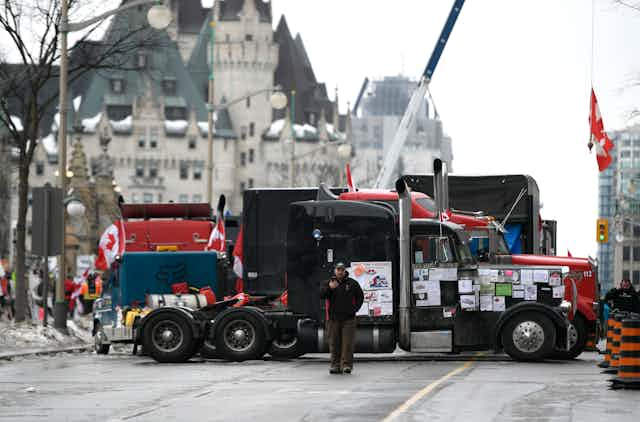The announcement criminalizes disruptive acts like blocking roads and border crossings, and gives police the power to respond with charges and penalties ranging from $100,000 in fines to a year in prison.
Two weeks after thousands of protesters in trucks rolled into Ottawa on Jan. 28 protesting vaccine mandates for cross-border truck drivers, hundreds of self-proclaimed “freedom convoy” activists remain embedded in the city’s downtown core. Persons with a variety of grievances related to far right causes and anti-vaccine sentiments remain in place with 400 to 500 trucks blockading downtown Ottawa.
From a disaster and emergency management perspective, the hazard being realized in Ottawa arises from specific human behaviours — or more accurately, misbehaviour. The protest has produced temporary increase in population that has evolved into an an unlawful occupation. As days turn into weeks, the chance of an ugly and tragic ending increases.
An appropriate and measured police response stressing de-escalation has emboldened protestors to dig in. Frustration from Ottawa residents is being misdirected towards local authorities, who are otherwise well-prepared to deal with routine emergency planning required for a variety of contingencies. But this is a non-routine and increasingly bizarre social hazard situation. And as occupiers hunker down to prolong the disruption, the chances of a dangerous stand-off between police and protesters increase.
Emergency plans
It is not out of the ordinary that an event of some sort will bring a temporary population influx into Canada’s capital city. What is out of the ordinary is the rare crisis situation Ottawa now is facing, where protestors continue to purposely operate outside of the bounds set for public safety at large events.
Activities ranging from celebrations to protests can bring tens of thousands into the city, albeit on a temporary basis. Such influxes of people have risks but do not necessarily represent a hazard.
For example, as part of Canada’s sesquicentennial celebration in July 2017, a French theatrical performance involving a giant robotic dragon and spider attracted 750,000 people to downtown Ottawa during a four-day period. As with most mass gatherings, people were able to come and go safely without incident. That event illustrated that Ottawa can safely manage events much larger than the current occupation.
To prevent disasters, emergency planning takes place on multiple levels to provide safety for large crowds and public spaces.
Examples of this planning are the guidance of the Major Planned Events Working Group in British Columbia, and the established special event-planning processes practised in cities like Ottawa and Toronto.
The current disaster unfolding in downtown Ottawa is a non-routine mass gathering and has many elements that undermine existing emergency planning. It is a population influx with no outflux, which is problematic, as those who stay behind are attempting to create their own infrastructure to sustain their occupation.
Those participating in the protest have selfishly decided that public health and safety guidelines do not apply to them. They have also engaged in subterfuge by swarming, distracting and subverting police. This all indicates that planning for the “freedom convoy” relies on organized systems to support the co-ordination and logistics of the occupation.
MOVE: A cautionary tale
Understanding other cases of how unusual hazards produced by urban occupations were brought to an end can shed light on what a worst-case scenario for Ottawa may look like. One lesser-known prolonged urban crisis that shares some of the same complexities as the Ottawa occupation was a situation from 1985 in Philadelphia.
MOVE is a Black communal movement combining Black nationalism and green anarchism. After a sordid history of racially charged and increasingly violent confrontations with police, MOVE retreated into a fortified row house in the middle of a residential block. In 1978, after a 15-month-long siege, a police officer was killed as hundreds of police officers swarmed the building the group was occupying.
Seven years later, in 1985, police used a helicopter to drop a bomb on the MOVE house to end another standoff, killing 11 people, including five children. The police and the city allowed the resulting fire to burn, destroying the surrounding neighbourhood and leaving 250 people homeless.
A Philadelphia Special Investigation Commission determined that choices made by authorities to end the standoff in a forceful manner were grossly negligent.
The tragic ending of the MOVE occupation and standoff is a cautionary tale. The rapid escalation of tensions resulting from actions to evict dedicated persons who occupy makeshift defensive positions in an urban setting can result in unintended and regrettable consequences.
Calls for police action
Authorities in Ottawa have been wise to take a risk-reduction approach of de-escalation and containment with the intention of giving the occupiers time to make their own choice to leave.
However, as the occupation drags on and nuisance levels increase, there will be additional pressure on the police to act. Current frustration and perceptions that authorities are unable to manage the situation are misplaced.
Read more: What the 'freedom convoy' reveals about the ties among politics, police and the law
A peaceful ending is still possible if police are able to facilitate a safe exit for occupiers who wish to leave. On the other hand, when lines are crossed and the continued occupation creates an intolerable public safety risk, authorities can quickly end the occupation by force at a time of their own choosing.
It will be unfortunate for Canada if those local, provincial or federal authorities who are eventually tasked to end the Ottawa occupation are required to choose between options which are all risky, dangerous and controversial.

